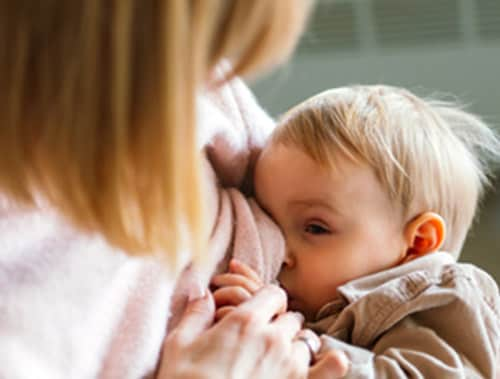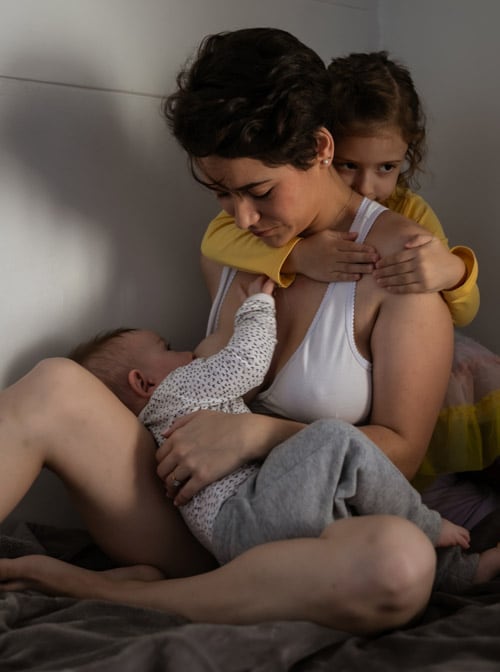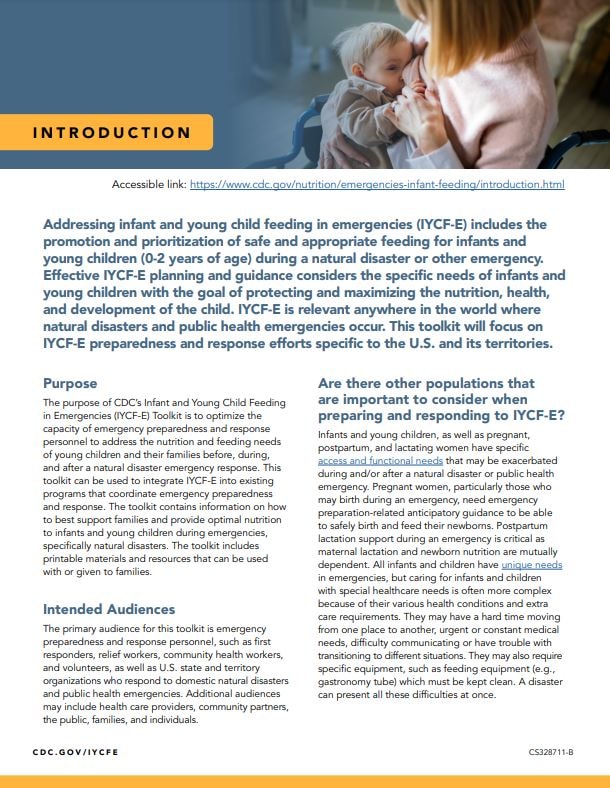IYCF-E Toolkit Introduction
Addressing infant and young child feeding in emergencies (IYCF-E) includes the promotion and prioritization of safe and appropriate feeding for infants and young children (0-2 years of age) during a natural disaster or other emergency. Effective IYCF-E planning and guidance considers the specific needs of infants and young children with the goal of protecting and maximizing the nutrition, health, and development of the child. IYCF-E is relevant anywhere in the world where natural disasters and public health emergencies occur. This toolkit will focus on IYCF-E preparedness and response efforts specific to the U.S. and its territories.
Purpose
The purpose of CDC’s Infant and Young Child Feeding in Emergencies (IYCF-E) Toolkit is to optimize the capacity of emergency preparedness and response personnel to address the nutrition and feeding needs of young children and their families before, during, and after a natural disaster emergency response. This toolkit can be used to integrate IYCF-E into existing programs that coordinate emergency preparedness and response. The toolkit contains information on how to best support families and provide optimal nutrition to infants and young children during emergencies, specifically natural disasters. The toolkit includes printable materials and resources that can be used with or given to families.

Intended Audiences
The primary audience for this toolkit is emergency preparedness and response personnel, such as first responders, relief workers, community health workers, and volunteers, as well as U.S. state and territory organizations who respond to domestic natural disasters and public health emergencies. Additional audiences may include health care providers, community partners, the public, families, and individuals.
Are there other populations that are important to consider when preparing and responding to IYCF-E?
Infants and young children, as well as pregnant, postpartum, and lactating women have specific access and functional needs that may be exacerbated during and/or after a natural disaster or public health emergency. Pregnant women, particularly those who may birth during an emergency, need emergency preparation-related anticipatory guidance to be able to safely birth and feed their newborns. Postpartum lactation support during an emergency is critical as maternal lactation and newborn nutrition are mutually dependent. All infants and children have unique needs in emergencies, but caring for infants and children with special healthcare needs is often more complex because of their various health conditions and extra care requirements. They may have a hard time moving from one place to another, urgent or constant medical needs, difficulty communicating or have trouble with transitioning to different situations. They may also require specific equipment, such as feeding equipment (e.g., gastrostomy tube) which must be kept clean. A disaster can present all these difficulties at once.

Why is infant and young child feeding important to address during emergencies?
Adequate nutrition is important in an emergency to keep families as healthy as possible. Infants and young children are particularly vulnerable during emergencies, when various exposures can lead to illness, infection, and potentially death. Breastfeeding is the safest way to feed infants and young children in emergency situations to prevent illness; however, natural disasters and public health emergencies can create unique challenges for breastfeeding families and feeding challenges for any family. Safe feeding and preparation of breast milk, complementary foods, infant formula, and appropriate cleaning and storing of infant feeding items are also important to
- minimize morbidity risks associated with feeding and
- maximize a child’s health and development.
What are some Challenges in IYCF-E?
- Displacement
Families who are experiencing an emergency may have to leave their homes and travel to a different location, city, state, or to a shelter. In rare circumstances, family members could be separated during an emergency, which can cause feeding challenges, especially for a baby who is breastfed. - Lack of family friendly spaces
When families are relocated, such as to a disaster shelter setting, they may not have privacy to breastfeed or express breast milk or have access to lactation support. Without access and support, parents may be less likely to breastfeed or express their milk, leading them to consider using infant formula instead. Families also require space to adequately clean and store infant feeding supplies, safely prepare infant food, and to hygienically change diapers. - Food and water insecurity and lack of adequate nutrition for mother and child
Infants, children, and pregnant and postpartum women are vulnerable to undernutrition, especially during emergencies. Infants and young children can become undernourished faster than adults. Undernourished children, compared to children of healthy weight, can become ill, and have a harder time recovering due to impaired immune systems. Families who are experiencing an emergency that affects their safe water source, power, access to resources, or the safety of their environment may find it more difficult to get, prepare and store food. Displaced families may also be unsure of what food and safe drinkable water will be available at their destination, how long they will be away, or how long the emergency will last, which makes it hard to pack and plan for an emergency. - Potential risks associated with feeding infant formula
Breastfeeding is the safest way to feed a baby during a natural disaster. Some parents, prior to an emergency, may be mixed feeding (feeding both breast milk and infant formula) or exclusively using infant formula; in these cases, it is important to provide support and guidance to families on how to feed their baby safely during an emergency. The potential risks and challenges associated with feeding infant formula during an emergency include 1) lack of access to a supply of infant formula, 2) accessing safe water for mixing infant formula and cleaning infant feeding supplies, 3) storing and handling infant formula safely, and 4) having access to space and supplies to properly clean and store infant feeding items. - Worsening of disparities
During times of crisis, families who have been marginalized, and/or have access or functional needs, are often impacted the most. This can be especially difficult if they live in an area that suffers disproportionate effects from the disaster or emergency. Systemic and structural racism, as well as individual implicit biases, create additional barriers for communities most at risk during emergencies, which may intensify racial and ethnic disparities. Families in these communities may be more susceptible to the disruption of breastfeeding and face additional barriers to safe feeding. It is critical to apply a health equity lens when developing policies, trainings, and implementation strategies for disaster preparedness, response, and recovery.
This toolkit aims to address challenges in infant and young child feeding in emergencies by providing practical information to assist those working with families during emergencies to keep families as healthy as possible. This toolkit may not address all infant and young child feeding challenges that families may face during a natural disaster. As additional IYCF-E preparedness and response information needs are identified, they will be added to this toolkit.
This toolkit provides information and guidance primarily for natural disaster situations. Breastfeeding is the safest way to feed infants and young children in emergency situations caused by natural disasters. Although rare, in certain emergencies breastfeeding may not be the safest option, although feeding previously expressed breast milk may be safe. For example, radiation and bioterrorism emergencies, specific infectious disease outbreaks, and some chemical exposures may require that families follow different guidance about safe infant and young child feeding. Relief workers and emergency preparedness and response personnel should follow emergency-specific guidance from local public health authorities when there may be exceptions to the recommendations to breastfeed.
The content in this toolkit is not intended to be a substitute for professional medical advice, diagnosis, or treatment. When needed, always consult with a qualified and licensed physician or other health care provider.

